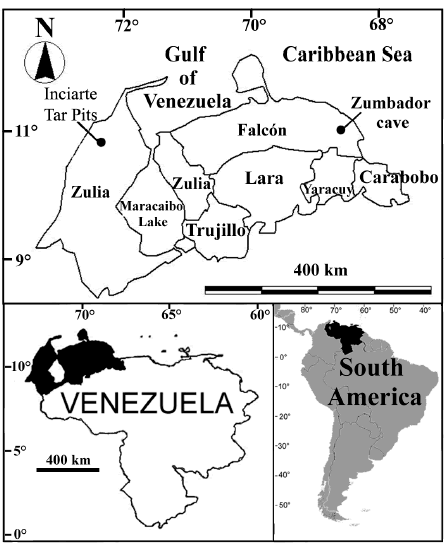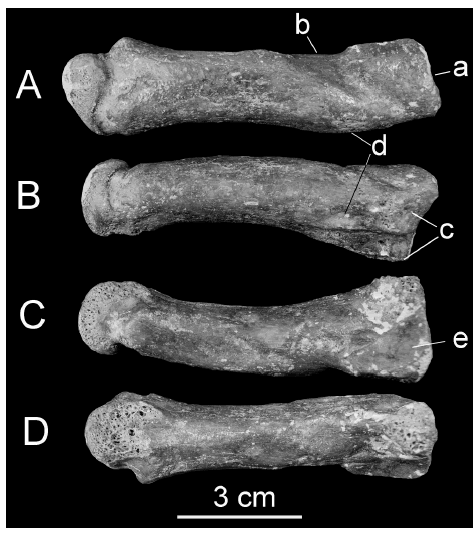Servicios Personalizados
Revista
Articulo
Indicadores
-
 Citado por SciELO
Citado por SciELO
Links relacionados
-
 Similares en
SciELO
Similares en
SciELO
Compartir
Ameghiniana
versión On-line ISSN 1851-8044
Ameghiniana v.43 n.2 Buenos Aires abr./jun. 2006
A first record of the Pleistocene saber-toothed cat Smilodon populator Lund, 1842 (Carnivora: Felidae: Machairodontinae) from Venezuela
Ascanio D. Rincón R.1
1 Instituto Venezolano de Investigaciones Científicas (IVIC), Centro de Ecología, Laboratorio de Biología de Organismos, Carretera Panamericana, km 11, Aptdo. 21827, C.P 1020-A Caracas, Venezuela. arincon@ivic.ve
Introduction
The first record of Smilodon Lund, 1842, was made based on a material found in Late Pleistocene deposits in caves near Lagoa Santa in eastern Brazil. Berta (1987) recognized two species of Smilodon, the small, slender S. gracilis (Cope, 1880) from Late Pliocene-Middle Pleistocene localities in North America and the larger, more robust, S. populator Lund, 1842 from Middle-Late Pleistocene localities in North and South America (Berta, 1987). In South America S. populator has been found in Ecuador, Peru, Bolivia, Brazil and Argentina (Berta, 1985), but has not been previously reported from Venezuela (Ochsenius, 1980). Here I report the first record of saber-toothed cat S. populator Lund, 1842 from Venezuela, found in two localities, Inciarte Tar Pits in Zulia State, and Zumbador Cave in Falcon State (figure 1).

Figure 1. Location map showing Inciarte Tar Pits and Zumbador Cave localities / mapa de ubicación de los pozos de asfalto de Inciarte y la cueva del Zumbador.
As a large predator, the preferred habitat of Smilodon has been interpreted as areas between savannas and wooded areas with substantial brushy undergrowth that could be used as den sites (Shaw, 2001; Webb and Rancy, 1996).
Systematic paleontology
CANIVORA Bowdich, 1821
FELIFORMIA Kretzoi, 1945
FELIDAE Gray, 1821
MACHAIRODONTINAE Gill, 1872
SMILODONTINI Kurtén, 1963
Genus Smilodon Lund, 1842
Smilodon populator Lund, 1842 Figures 2-3

Figure 2. Smilodon populator Lund, 1842, right first lower molar (MBLUZ-P-1629); A, lateral; B, occlusal views. Right fourth lower premolar (MBLUZ-P-1630); C, lateral; D, occlusal views. tld=talonid; prd=protoconid; pad=paraconid; pci=posterior cingulum; poc=posterior cusplet; pc=principal cusp; ac=anterior cusplet / Smilodon populator Lund, 1842, primer molar inferior derecho (MBLUZ-P-1629); A, vista lateral; B, vista oclusal. P4 cuarto premolar inferior derecho (MBLUZ-P-1630); C, vista lateral; D, vista oclusal. tld=talonido; prd=protoconido; pad=paraconido; pci=cíngulo posterior; poc=cúspide posterior; pc=cúspide principal; ac=cúspide anterior.

Figure 3. Smilodon populator, right metacarpal II (MBLUZ-P- 5111); A, dorsal; B, medial; C, lateral and D, ventral views; a, articulation for trapezoid; b, radial artery; c, articulation for trapezium; d, insertion of extensor carpi radialis muscle; e, articulation for third metacarpal / Smilodon populator, II metacarpal derecho (MBLUZ-P-5111); A, vista dorsal; B, vista medial; C, vista lateral y D, vista ventral; a, articulación para trapezoide; b, arteria radial; c, articulación para trapezium; d, área de inserción del músculo extensor carpi radialis; e, articulación para III metacarpal.
Material and methods. MBLUZ-P-1629 (Museo de Biología de la Universidad del Zulia, Sección de Paleontología), a right fourth lower premolar (figures 2.C, D) and MBLUZ-P-1630, a right first lower molar (figures 2.A, B), both coming from Inciarte Tar Pits locality. MBLUZ-P-5111, right metacarpal II (figure 3); and MBLUZP- 5112, right upper canine. Both coming from Zumbador Cave.
Data on measurements for S. populator are from Kurtén and Wederlin (1990), and for S. gracilis from Berta (1987). The measurements were taken with a millimeter caliper following Berta's (1987) nomenclature for tooth morphology, and Kurtén and Wederlin (1990) for the metacarpal.
Geographical provenance. The Inciarte Tar Pits (10º 47' 42,6'' Lat. N - 72º 14' 20,8'' Long. W) is located in the Sierra de Perijá foothills near the Cachirí river, northwest of the La Paz Oil Beds, Zulia State. Zumbador Cave (10º 51' 26'' Lat. N, 68º 36' 41'' Long. W) (Fa. 116) is located in Yumare area, 15.5 Km. south-southwest from Yaracal, cerro Misión, Falcon State (figure 1).
Description. The P4 (MBLUZ-P-1630) consists of a large principle cusp flanked by subequal cusplets. The anterior cusplet is smaller than posterior. The principle cusp and both the anterior and posterior cusplets are medially oriented. The posterior cingulum is less pronounced than in S. gracilis. Measurements of MBLUZ-P-1630 fall into the upper size range of S. populator and it is much larger than S. gracilis (table 1).
Table 1. Measurements of lower fourth premolar and first molar in Smilodon populator Lund, 1842, Smilodon gracilis (Cope, 1880), MBLUZ-P-1630, and MBLUZ-P-1629 (measurements in millimeters), (* estimate) / medidas del cuarto premolar y primer molar inferiores en Smilodon populator, Smilodon gracilis, MBLUZ-P-1630, y MBLUZ-P-1629 (medidas en milímetros), (* estimado).

In the M1 (MBLUZ-P-1629) the protoconid blade is longer and taller than the paraconid blade. There is a pronounced shearing surface present on the labial surface of both the paraconid and protoconid blades. A small talonid is developed on the M1 composed of a smaller entoconid, hypoconid and metaconid. As with the P4 (MBLUZ-P-1629) its measurements are in the upper limit of S. populator and are greater than S. gracilis (table 1).
The anterior border of the fragment of the upper canine (MBLUZ-P-5112) has the fine serrations typical of many members of the Machairodontidae. These are visible under magnification. Enough of the fragment is preserved to indicate a mediolateral compression of the tooth and a gentle anteroposterior curvature.
In the metacarpal II (MBLUZ-P-5111), the proximal articular surface for the trapezoid lacks the strongly triangular shape seen in true cats. In anterior view, the oblique groove for the radial artery is prominent. Medially, the swelling for the insertion of the tendon of the extensor carpi radialis muscle, which functions to extend and abduct the forepaw, is more medially pronounced than in true cats. In medial view, the facet for the trapezium is elongated proximodistally. The shape of the metacarpal facet is broad and elongated proximodistally, as is characteristic of the genus. A facet for the magnum is lacking.
Greatest length and shaft width are in the upper size range of S. populator, but the distal width falls into the lower limits of S. populator and upper limits of S. gracilis (table 2).
Table 2. Measurements of Metacarpal II in Smilodon populator, Smilodon gracilis and MBLUZ-P-5111 (measurements in millimeters) / medidas del II Metacarpal en Smilodon populator, Smilodon gracilis y MBLUZ-P-5111 (medidas en milímetros).

Discussion
At present, there are two alternative hypotheses about Smilodon taxonomy. Berta (1987) proposed that Late Pleistocene sabertooth cats are a monospecific taxa (S. populator) that include as junior synonyms, S. floridanus Leidy, 1889, S. californicus Bovard, 1907, and S. fatalis Leidy, 1868. These species had been distinguished based primarily on size; however Berta (1987) felt that size was not of primary importance in the recognition of species of Smilodon. Kurtén and Werdelin (1990) reviewed the morphometric data provided by Berta (1985, 1987) and suggested that S. fatalis and S. populator are sufficiently distinct to justify a separate specific designation. Based on their analysis they recognized in South America S. populator, as the species with a distribution east of the Andes, and distinguished from the North American S. fatalis by the following characters: generally larger size, narrower skull with cranial part elongated relative to facial part, high nasals resulting in nearly straight dorsal profile, marked angle between mastoid and occipital plane, more "graviportal" limb bones, and extremely massive metapodials (Kurtén and Wederlin, 1990). They also recognized the presence of Smilodon fatalis from the west coast of South America in Peru and Ecuador, which Berta had included in S. populator.
The morphological characteristics of the P4 (MBLUZ-P-1629) and M1 (MBLUZ-P-1630), and the right second metacarpal (MBLUZ-P-5111), coincide with those proposed by Berta (1987) for Smilodon, and their measurements are comparable with S. populator based on the data from Kurtén and Wederlin (1990).
Acknowledgements
I am grateful to John Moody and Ángel Viloria for their help with field and laboratory work and Greg McDonald for comments to the original manuscript.
Bibliography
Berta, A. 1985. The status of Smilodon in North and South America. Contributions in Science, Natural History Museum of Los Angeles County 370: 1-15.
Berta, A. 1987. The sabercat Smilodon gracilis from Florida and a discussion of its relationships (Mammalia, Felidae, Smilodontini). Bulletin of the Florida State Museum, Biological. Sciences 31: 1-63.
Bovard, J.F. 1907. Notes on Quaternary Felidae from California. University of California Publication Bulletin of Department of Geology 5: 155-170.
Cope, E.D. 1880. On the extinct cats of America. American Naturalist 14: 833-858.
Kurtén, B. and Werdelin, L. 1990. Relationships between North and South American Smilodon. Journal of Vertebrate Paleontology 10: 158-169.
Leidy, J. 1868. Notice of some vertebrate remains from Hardin County, Texas. Proceedings of Academy of Natural and Science of Philadelphia, pp. 174-176.
Leidy, J. 1889. The saber tooth tiger of Florida. Proceedings of Academy of Natural and Science of Philadelphia, pp. 29-31.
Lund, P.W. 1842. Blik paa Brasiliens Dyreverden för sidste jordomvaeltning. Fjerde Afhandling: Fortsaettelse af Pattedyrene. Lagoa Santa d. 30 Januar 1841. Copenhague. -K. Danske videnskabernes Selskabs naturvidenskapelige og mathematiske Afhandlinger IX:137- 208. (Portuguese transl. Lund, P.W. 1950. Chapert X:317-377).
Ochsenius, C. 1980. Cuaternario en Venezuela. Introducción a la paleoecología en el Norte de Suramérica. Ediciones UNEFM. Cuadernos Falconianos 3: 67 pp.
Shaw, C.A. 2001. The Sabertoothed cats. Terra 38: 26-27.
Webb, S.D. and Rancy, A. 1996. Late Cenozoic Evolution of the Neotropical mammal fauna. In: J.B.C. Jackson, A.B. Budd and A.G. Coates (eds.), Evolution and Environment in tropical America, The University Chicago Press, Chicago, pp. 335- 358.
Recibido: 4 de noviembre de 2004.
Aceptado: 3 de octubre de 2005.














